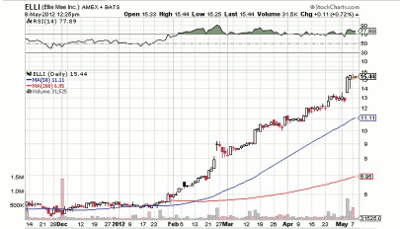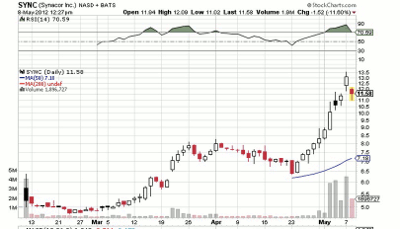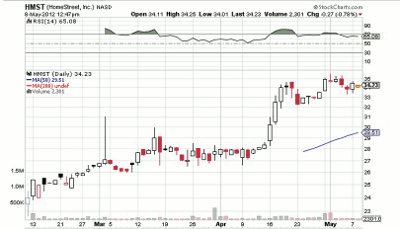Although the general market is retreating, there are several newly public names that show promise as future buy candidates. MoneyShow’s Kate Stalter continually tracks recent IPOs for signs of technical breakouts, and here are three of her top picks to watch.
One of the scans I frequently revisit here focuses on recent IPOs. This is a particularly constructive scan, as it reveals many top price performers and others that are setting up in potentially productive chart patterns.
Among stocks that went public in 2011 and 2012, one name that’s risen to the top is Ellie Mae (ELLI), which makes software for mortgage originators.
The stock made its debut on the American Stock Exchange in April 2011 at $6. It’s not uncommon to see new IPOs pull back after an initial pop. The stock rallied to a high of $7.60 a few weeks after its IPO, then went into a nine-month correction.
It began its uptrend in February, following a better-than-expected fourth-quarter report. So far this year, Ellie Mae is up an almost unbelievable 173%. After running up in the previous three months, the stock bolted nearly 21% last week on the heels of the company’s first-quarter report.
After retreating from an all-time high of $15.80 Monday, Ellie Mae edged up Tuesday, and was trading at around $15.40 mid-session.
The stock is way out of buy range right now, as it rallied to a new high on Monday before reversing intraday. This is a strong watch-list candidate at this moment. Analysts expect earnings growth of 58% this year, to 38 cents per share, and 66%, to 63 cents per share in 2013.
Watching its chart, I want to see a pullback that would flush out some holders lacking in conviction, and give bargain shoppers a chance to grab shares at a lower price. Support above the 50-day moving average—or even a shorter-term price line—would be key. At this juncture, it’s too soon to identify a potential buy point.
Another big-moving recent IPO—that’s currently out of buy range, but worth watching—is Synacor (SYNC). The company makes a technology platform that allows cable operators, telecoms, and other digital content providers to manage digital delivery and services.
Shares went public at $5 in February, and underwent the typical post-IPO pullback. However, in this case, the pullback was short-lived. The stock rallied to a high of $8.24 early last month, then consolidated again, along with the broader market.
The stock cleared the buy point of its consolidation on April 30. On May 1, the company said it was acquiring privately held Carbyn, a cloud-based platform to deliver apps to various mobile devices.
As I mentioned above, Synacor is well extended from any buy point. The stock bolted 15% Monday, to a new high of $13.60. It gapped lower in Tuesday’s general market selloff, and was trading at around $11.32 mid-day.
As is the case with Ellie Mae, I’m prepared to patiently wait through a pullback for the stock to present a new entry opportunity. It’s too soon to say what the next buy point might be.
With Synacor, too, the fundamental case is promising. The company became profitable in 2011, and analysts see earnings per share of 16 cents a share this year, up 15%. In 2013, that’s expected to grow a whopping 138%, to 38 cents per share.
Of course, estimates can be wrong—either on the high or low side—but they give an indication of the level of conviction that institutions have in a stock at any given time.
Both Ellie Mae and Synacor are small caps. In fact, many of the most promising names among recent IPOs are small- and mid-cap stocks.
A small, thinly traded recent IPO is HomeStreet (HMST), a regional bank with 38 branches in Oregon, Washington, and Hawaii. It’s headquartered in Seattle.
The company almost became insolvent during the economic and financial-market meltdown in 2008 and early 2009. The company got a new CEO in 2010, and opted to raise capital through the public markets.
HomeStreet’s stock went public at $44 in February, and then underwent a 2-for-1 split only a few weeks later. It rallied to a split-adjusted high of $31.03 in early March before consolidating for several weeks.
The stock vaulted nearly 20% in heavy volume the week ended April 20. There was no specific news, but it’s not unheard of to see accumulation—or selling—without any big news item.
The stock rallied to a high of $34.55 on May 1, and is currently finding support just above its ten-day average. A few hours into Tuesday’s session, Synacor was trading at around $34.23.
The company is scheduled to present at an investment banking conference on Thursday. Those events often result in stock price increases, as the institutional investors and analysts hear something they like in the company’s plans, spurring a round of buying.
There are a couple red flags about HomeStreet. First, it’s a very thinly traded stock, moving only 41,000 shares per day. That can increase downside risk for retail investors; if one institution opts out, it can send shares sharply lower.
The second red flag pertains to the fundamentals. Although analysts see earnings growing at a triple-digit rate this year, to $6.80 per share, consensus estimates call for a decline of 7%, to $6.35 per share in 2013. While stocks often rise on earnings declines if the company beats views, a decline can also accompany stagnant price action.
Of course, it’s too early to predict how that will pan out. At the moment, the stock is a solid price performer, with the ten-day moving average support an encouraging development. At this time, the stock is in buy range between the ten-day and its previous high of $35.55.
At the time of publication, Kate Stalter did not own positions in any of the stocks mentioned in this column.
Related Reading:
























